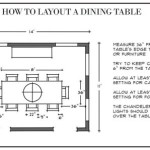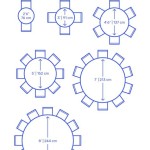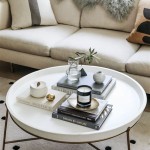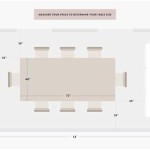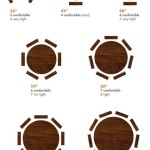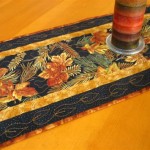Determining the Appropriate Length for a Table Runner
Selecting the correct length for a table runner involves considering several factors related to the table's size and shape, the desired aesthetic, and the formality of the setting. A table runner serves multiple purposes: it can protect the table from scratches and spills, enhance the visual appeal of the table setting, and tie together the overall decor of the room. Choosing the wrong size, however, can detract from these benefits and create an unbalanced or awkward look.
A well-chosen table runner can significantly elevate the dining experience, whether it's for a casual family meal or a formal dinner party. The ideal length depends primarily on the table's dimensions, but personal preferences and the intended use of the runner also play a crucial role. Understanding these influencing factors is essential for making an informed decision.
This article will provide a comprehensive guide to determining the appropriate length for a table runner, covering different table sizes, aesthetic considerations, and practical implications. By considering these factors, readers can confidently select a table runner that complements their table and enhances their decor.
Understanding Table Dimensions
The first and most critical step in determining the correct table runner length is to accurately measure the table. This involves measuring the length and width of the tabletop using a measuring tape. It's recommended to measure in inches or centimeters to ensure precision. For round or oval tables, measure the diameter or the longest dimension across the table.
Once the table's dimensions are known, the desired overhang can be calculated. The overhang refers to the amount of runner that drapes over each end of the table. This is a matter of personal preference, but generally, an overhang of 6 to 12 inches on each end is considered standard for a more casual look. For a more formal setting, a longer overhang of 12 to 18 inches may be preferred.
To calculate the ideal runner length, add the desired overhang on each end to the table's length. For example, if the table is 60 inches long and the desired overhang is 10 inches on each end, the ideal runner length would be 60 + 10 + 10 = 80 inches. This calculation provides a starting point, which can be adjusted based on individual preferences and the specific design of the runner.
Consideration should also be given to the width of the table. While the length is the primary factor, the width of the runner should be proportionate to the table's width. A runner that is too narrow may appear insignificant, while a runner that is too wide may overwhelm the table. The ideal width of the runner depends on the table's width and the desired aesthetic.
For a standard rectangular table, a runner width of one-third to one-half of the table's width is usually recommended. For instance, a table that is 40 inches wide might look best with a runner that is 13 to 20 inches wide. These are general guidelines, and personal preferences and the overall design of the table setting should be taken into account. It is always preferable to err on the side of caution and choose a runner that is slightly wider rather than too narrow.
Aesthetic Considerations and Formal vs. Casual Settings
Beyond the table's dimensions, the aesthetic of the room and the formality of the occasion greatly influence the ideal table runner length. A longer overhang typically conveys a more formal and elegant look, suitable for dinner parties or special events. A shorter overhang, or even a runner that simply covers the tabletop without any overhang, is more appropriate for casual gatherings or everyday use.
The choice of fabric also plays a significant role in the overall aesthetic. Heavier fabrics, such as velvet or brocade, tend to drape well and create a luxurious feel, making them suitable for formal settings. Lighter fabrics, such as cotton or linen, are more casual and versatile, ideal for everyday use or informal gatherings. The weight and texture of the fabric will influence how the runner hangs and contributes to the overall appearance.
Color and pattern should also complement the existing decor. A table runner can serve as a focal point, adding a pop of color or pattern to a neutral table setting. Alternatively, it can blend seamlessly with the existing color scheme, providing a subtle layer of texture and visual interest. Consider the colors of the tablecloth, placemats, and other table accessories when selecting a table runner to ensure a cohesive and harmonious look.
The placement of the runner is another aesthetic consideration. Traditionally, a table runner is placed lengthwise down the center of the table. However, it can also be placed widthwise across the table, either as a single runner or multiple runners serving as placemats. This creates a more contemporary and informal look, which is particularly suitable for smaller tables or buffet setups. The orientation of the runner can significantly alter the visual impact of the table setting.
Consider the other elements of the table setting. Chargers, dinnerware, glassware, and centerpieces all contribute to the overall aesthetic. The table runner should complement these elements, enhancing their visual appeal rather than competing with them. For example, a simple, understated runner may be preferable if the dinnerware is highly ornate or the centerpiece is particularly striking. Conversely, a bold and colorful runner can add personality to a minimalist table setting.
Practical Implications and Runner Types
Beyond aesthetics, practical considerations also influence the choice of table runner length. The primary function of a table runner is to protect the table from spills and scratches. A longer runner provides more extensive coverage, particularly if it extends beyond the edge of the table. This can be especially important if the table is made of delicate material, such as polished wood or glass.
The type of table runner also impacts the ideal length. Standard table runners, which run lengthwise down the center of the table, typically require the overhang calculation described earlier. However, other types of runners, such as those designed to be used as placemats or runners with decorative embellishments, may have different length requirements.
Buffet runners, which are typically wider and shorter than standard runners, are designed to cover a larger portion of the table's surface. These runners are often used to protect the table from spills and scratches during buffet-style meals. The length of a buffet runner should be sufficient to cover the main serving area, with a minimal overhang on each end. Consider the types of dishes and serving utensils that will be placed on the table when determining the appropriate length for a buffet runner.
Runners with decorative embellishments, such as tassels, fringe, or beads, may require additional length to accommodate these features. The embellishments should hang freely from the edge of the table, without dragging on the floor or becoming tangled. The additional length required will depend on the size and style of the embellishments. Accurate measurement is essential to ensure that the embellished runner fits properly and looks aesthetically pleasing.
The material of the table runner can also affect its practical performance. Stain-resistant fabrics, such as those treated with a protective coating, are ideal for protecting the table from spills. Durable fabrics, such as linen or cotton blends, are less likely to wrinkle or fray, making them suitable for everyday use. Consider the fabric's properties when selecting a table runner, taking into account its stain resistance, durability, and ease of cleaning.
Finally, consider the table's shape. While rectangular tables are the most common, round, oval, and square tables also require specific considerations. For round tables, a square or circular runner placed in the center is a common choice. The diameter of the runner should be proportionate to the table's diameter. For oval tables, a rectangular runner can be used, but it is important to ensure that the overhang is evenly distributed on both ends. Square tables offer more versatility, accommodating both square and rectangular runners. Understanding the table's shape is crucial for achieving a balanced and aesthetically pleasing look.

Table Runner Size Guide Diy Round
Ultimate Table Runner Size Guide

What Size Table Runner Should You Use On Your See A Standard 108 X14 Looks Like Round Tablecloth Sizes

The Best Round Table Runner Ideas Arinsolangeathome

How Long And Wide Should A Table Runner Be Much Fabric Do I Need Plus Great Tutor Burlap Diy Wedding Crafts

Sizing Chart For Table Clothes And Runners Cloth Runner Size Diy

Table Runner Size Chart Create The Best Look For Your Knockoffdecor Com

What Is The Standard Table Runner Size

How Wide Is A Table Runner Average Length For Your Size Make 60 Inch Round

Ask Madelyn Sizes For Table Runners Handwoven
Related Posts

